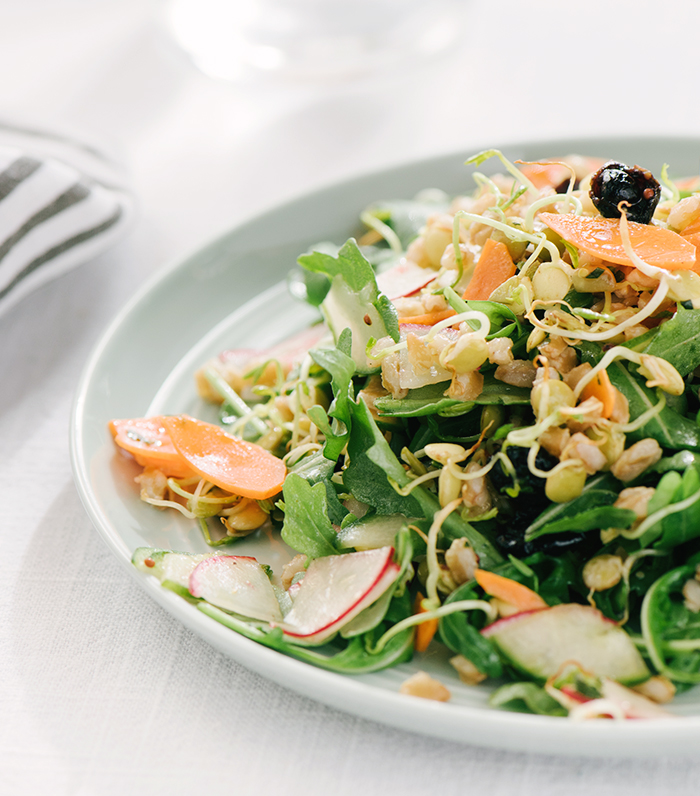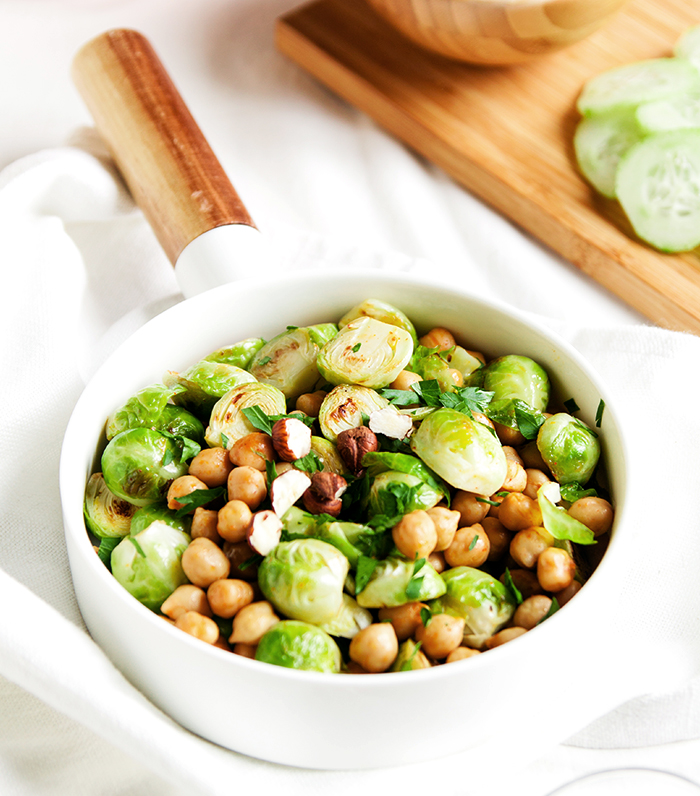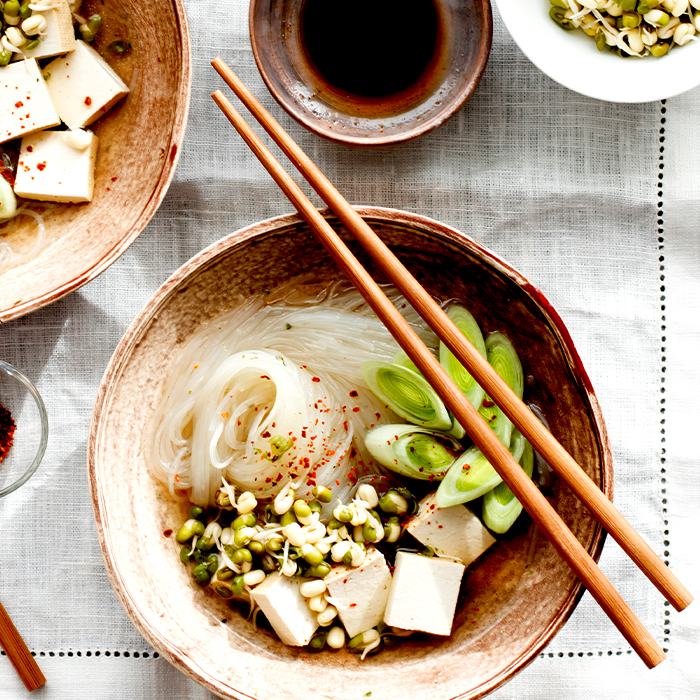Meet the Macrobiotic Diet: A Plant-Based Lifestyle That Helps You Live Longer

It's legitimately impossible to keep up with all of the diets floating around. There are so many. It's hard to decipher what's right for you in the long run. However, the methods that transcend traditional weight-loss goals or fad diets and are more reminiscent of positive lifestyle changes warrant recognition. This is where the macrobiotic diet comes in.
"The macrobiotic diet was established in Japanese monasteries hundreds of years ago to cure illnesses and has evolved from a once very restrictive diet into a holistic approach to health and well-being," explains nutritionist Tamara Rausch, who is the product manager for international wellness company Lycored. "The main idea is to balance the yin and yang elements of food and major principles including reducing animal product, eating locally farmed and seasonal foods, and consuming meals in moderation. The founder, George Ohsawa, introduced the oriental concept of health to Westerners in the mid-20th century when he moved from Japan to Paris. Macrobiotics goes even one step further and touches the body, mind, and emotions within an individual."
Wondering what truly makes this diet different from others? "The modern macrobiotic diet and lifestyle habits helps with chronic degenerative diseases, and lessens health issues generally attributed to aging. This is why people are looking for new dietary habits to benefit from the good in our food," explains Rausch. "The belief is that the macrobiotic concept has anti-aging effects and the diet itself has age-reversing potential. The mechanism of action is that the macrobiotic lifestyle as a holistic approach slows down cellular aging by delivering micronutrients to all of the cells in the body resulting in glowing skin and hair, and increased endurance."
Research shows the macrobiotic diet is a holistic alternative to help with cancer and chronic diseases such as type 2 diabetes, chronic fatigue, and fibromyalgia. Charles Passler, DC, nutritionist and founder of wellness program Pure Change, also points out the various health-focused benefits of macrobiotics. "A macrobiotic diet is not only what you eat but when you eat it, where you source the food from, and how you consume it," says Passler. "Eating a macrobiotic diet tends to lower inflammation and the risk of cancer due to the high level of antioxidants you'll consume. It also seems to promote heart health and lower blood pressure because of its high fiber content. Lastly, it can help you with weight loss because it's low in complex carbs and rich in nutrient-dense foods."
Basic Principles of the Macrobiotic Diet

Dr. Passler calls out the basic principles to understand when beginning the macrobiotic diet:
1. Food must be locally grown and sourced.
2. Consume mostly organic and raw foods.
3. Eat vegetables that are in season.
4. There's an emphasis on plant-based foods over meat.
5. This diet is higher in fiber.
6. A lot of antioxidants need to be involved.
7. This diet promotes the intake of complex carbs.
8. Food must be consumed slowly and mindfully.
9. Avoid packaged and processed foods, dairy, most fruits, coffee, and nightshade vegetables.
Best Foods and Vegetables for the Macrobiotic Diet

"Key foods of a macrobiotic diet include organically grown whole grains with a weight of 40% to 60% in the most unprocessed way possible," explains Rausch. "The more natural the better is the overriding rule. Twenty to 30% of weight should come from organic and locally grown vegetables that can be consumed either raw or prepared by steaming or boiling prepared with unprocessed oil. A small portion can also come from fresh salad."
Rausch continues: "It's very important to learn the difference about daily recommended varieties and occasional options, as some choices are only recommended two to three times a week. You should also pay attention to naturally choose seasonal options, which is important for macrobiotics."
Rausch recommends the below:
Vegetables. Vegetables for daily use include green cabbage, kale, broccoli, cauliflower, onions, daikon radish, and carrots. For occasional use in season, you can vary between cucumber, celery, lettuce, and herbs. Vegetables that are not recommended for regular use include potatoes, peppers, spinach, beets, and zucchini.
Beans and sea vegetables. This includes lentils and chickpeas along with plant-based protein products such as tofu, tempeh, and natto. Sea vegetables are a good source of vitamins and minerals to add to your daily diet.
To eat occasionally, Rausch suggests fresh white-meat fish, fresh fruits as dessert, and lightly roasted nuts and seeds as an occasional snack.
On the same accord as Rausch, Dr. Passler is a proponent of consuming leafy vegetables. "Organic leafy greens like cabbage and bok choy are rich in chlorophyll that can neutralize toxins in your intestines and improve the quality of your skin," he Passler. "They're also high in magnesium, which is helpful for relaxation."
Passler also recommends incorporating the following into your diet: "Broccoli and cauliflower that contain phytonutrients called indoles, which are great for balancing hormones. Sea vegetables and seaweeds, which are a great source of the nutrient Iodine, for healthy thyroid function and metabolism. Unprocessed grains like organic brown rice, quinoa, and amaranth, which are high in fiber, to promote heart health. Lastly, miso soup which is high in hormone-balancing phytonutrients.
Macrobiotic Diet Plan and Recipe

Here's a classic macrobiotic diet plan Dr. Passler suggests for anyone trying this out:
Breakfast: Organic green tea and wild salmon with brown rice and sautéed veggies
Lunch: Seaweed salad, miso soup, steamed veggies, and quinoa
Dinner: Soba noodles, tempeh, and sautéed veggies
When it comes to recipes, Dr. Passler says you can't go wrong with a hearty miso soup since it's easy to prepare and highly nutritious. Add the following to basic miso soup:
Broccoli
Bok choy
Seaweed
Glass noodles
Wild salmon
A touch of sesame seed oil
Tamari (gluten-free soy sauce), to taste
He also recommends tempeh to his patients. "My favorite way to prepare it is sautéed in sesame seed oil with pumpkin seeds and broccoli served over quinoa," he says.
Macrobiotic Diet Lifestyle Changes
Since the macrobiotic diet is larger than simply what you put inside your body, there are important holistic lifestyle changes to take into consideration. "You should only eat when hungry, chew properly, and eat in an orderly and relaxed manner," explains Rausch. "Drinking is recommended moderately when thirsty. Another principle is to improve sleep quality by not eating two to three hours before sleeping and retire before midnight. People are recommended to spend as much time outside as possible."
Reusch says the macrobiotic concepts focus on the positive in all aspects of life. So the routine of all of the above leads to happiness, gratefulness, and beauty from within.
Ed. note: Please consult your doctor before making any dietary changes.
This article is provided for informational purposes only and is not intended to be used in the place of advice of your physician or other medical professionals. You should always consult with your doctor or healthcare provider first with any health-related questions.


